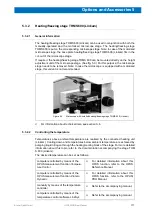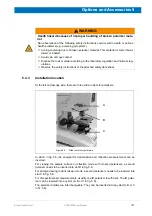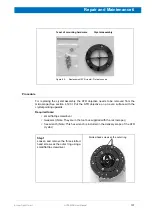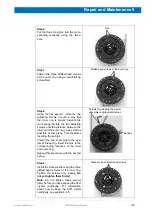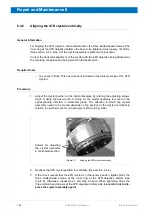
130
HYPERION User Manual
Bruker Optik GmbH
Repair and Maintenance 6
6.3
Evacuating the detector dewar
6.3.1
General Information
The operating temperature of the MCT detectors is significantly below room tempera-
ture. To achieve the required operating temperature, the MCT detectors are cooled down
with liquid nitrogen. The available MCT detectors have different nominal hold times
1
: 8,
12 or 24 hours. To provide for the longest possible hold time, the MCT detector is inte-
grated in a dewar. So, the actual hold time strongly depends on the quality of the vac-
uum in the detector dewar.
If the actual hold time decreases considerably with regard to the nominal hold time, the
detector dewar vacuum needs to be restored. The existence of condensation water on
the detector outside indicates that the vacuum must be stored soon. Another indication
that a vacuum restoration is required is a failed
Ice Band Test
2
. If the MCT detector out-
side is iced the detector dewar vacuum must be restored immediately.
The MCT detector element is situated in an evacuable dewar. The dewar vacuum is
restored by evacuating the detector dewar with a vacuum pump. For this purpose, the
MCT detector needs to be removed from the microscope.
6.3.2
Evacuating the MCT detector dewar
Required evacuating equipment
• Vacuum pump (turbo molecular pump or oil-free high-vacuum pump that is capa-
ble of generating a vacuum of at least < 10
-5
mbar)
• Adapter for connecting the vacuum pump to the MCT detector dewar
• Shut-off valve
• 2x flexible metal hoses
i
The above listed evacuating equipment is NOT included in the standard delivery scope
of the MCT detector. If desired, Bruker offers suitable evacuating equipment (part num-
ber S105-V2, D126 and I10290). Alternatively, Bruker also offers the service of evacuat-
ing the MCT detector dewar (part number SD128). This option requires the removal of
the MCT detector from the microscope and the sending of the complete MCT detector to
Bruker for evacuation.
1. The hold time indicates how long the cooling effect of the liquid nitrogen lasts.
2. The
Ice Band Test
checks whether there is a thin ice layer on the detector element. This in turn is an indica-
tion of the vacuum quality in the MCT detector dewar. The
Ice Band Test
is part of the PQ test protocol. For
detailed information, refer to the OPUS Reference Manual.
Summary of Contents for HYPERION
Page 1: ...HYPERION User Manual I 24319 ...
Page 56: ...54 HYPERION User Manual Bruker Optik GmbH Overview 3 ...
Page 148: ...146 HYPERION User Manual Bruker Optik GmbH Repair and Maintenance 6 ...
Page 168: ...166 HYPERION User Manual Bruker Optik GmbH Specifications A ...
Page 172: ...170 HYPERION User Manual Bruker Optik GmbH Measurement parameters B ...
Page 174: ...172 HYPERION User Manual Bruker Optik GmbH Spare parts and consumables C ...
Page 175: ...173 Bruker Optik GmbH HYPERION User Manual D System diagram ...
Page 176: ...174 HYPERION User Manual Bruker Optik GmbH System diagram D ...


